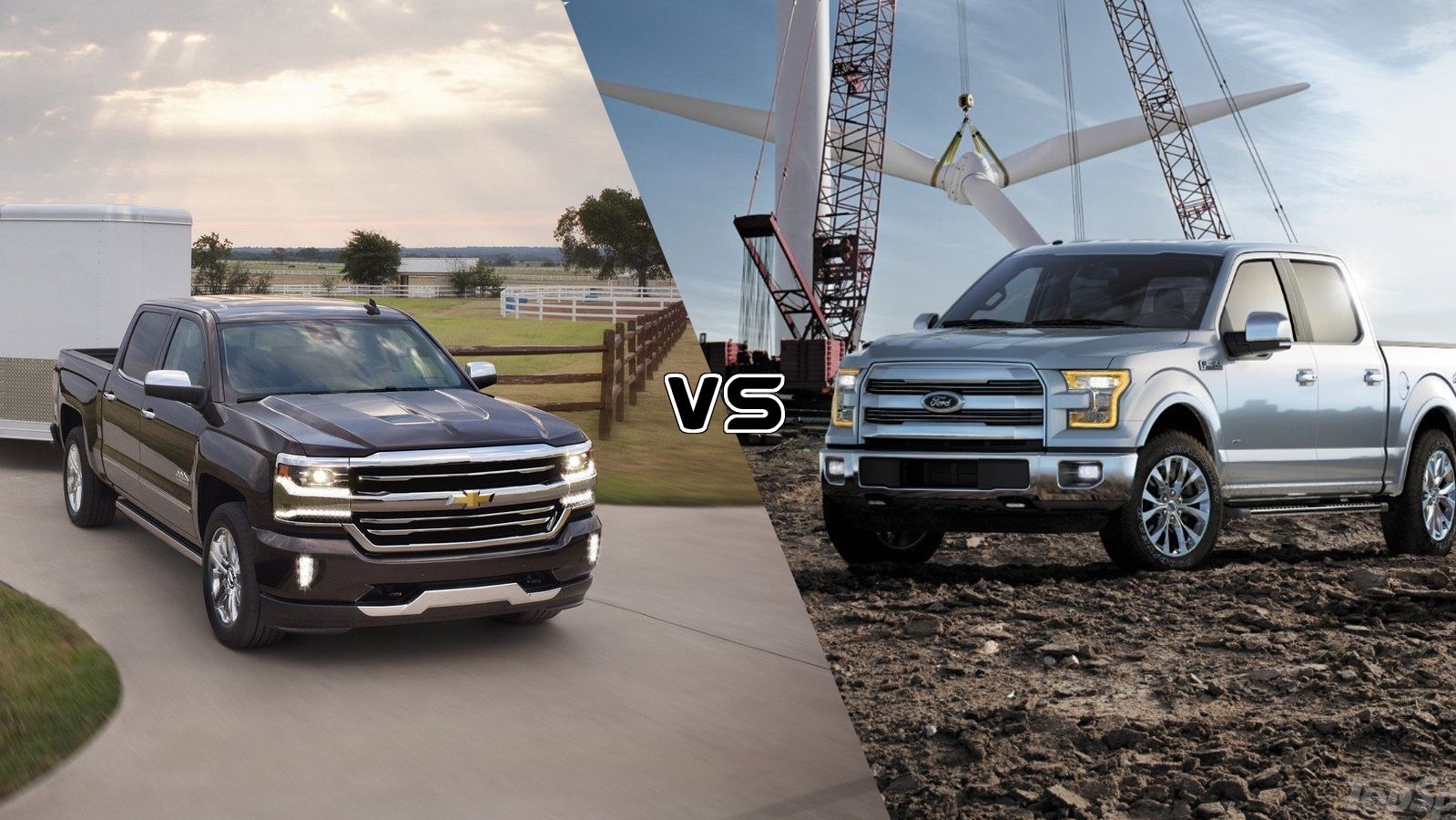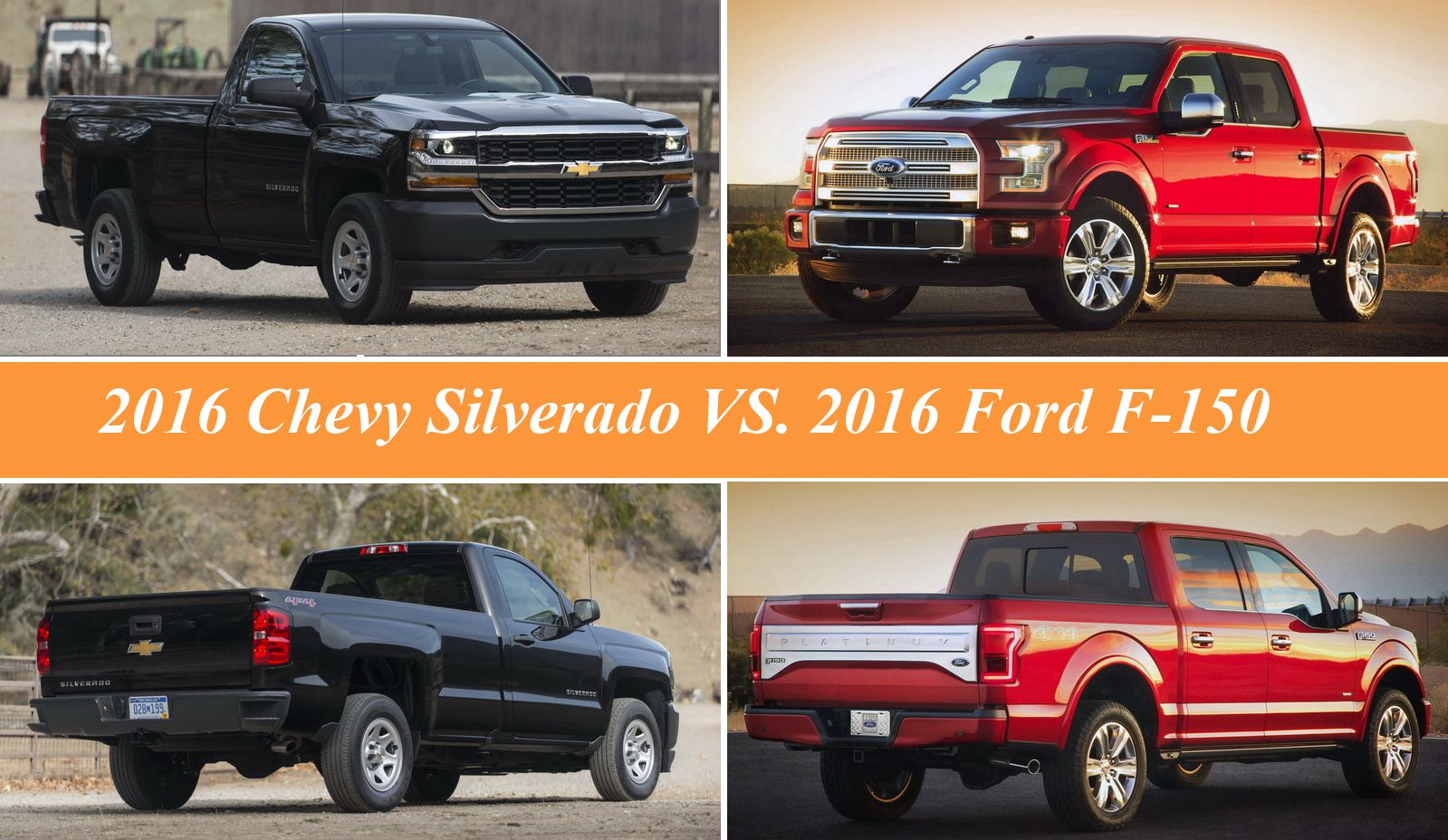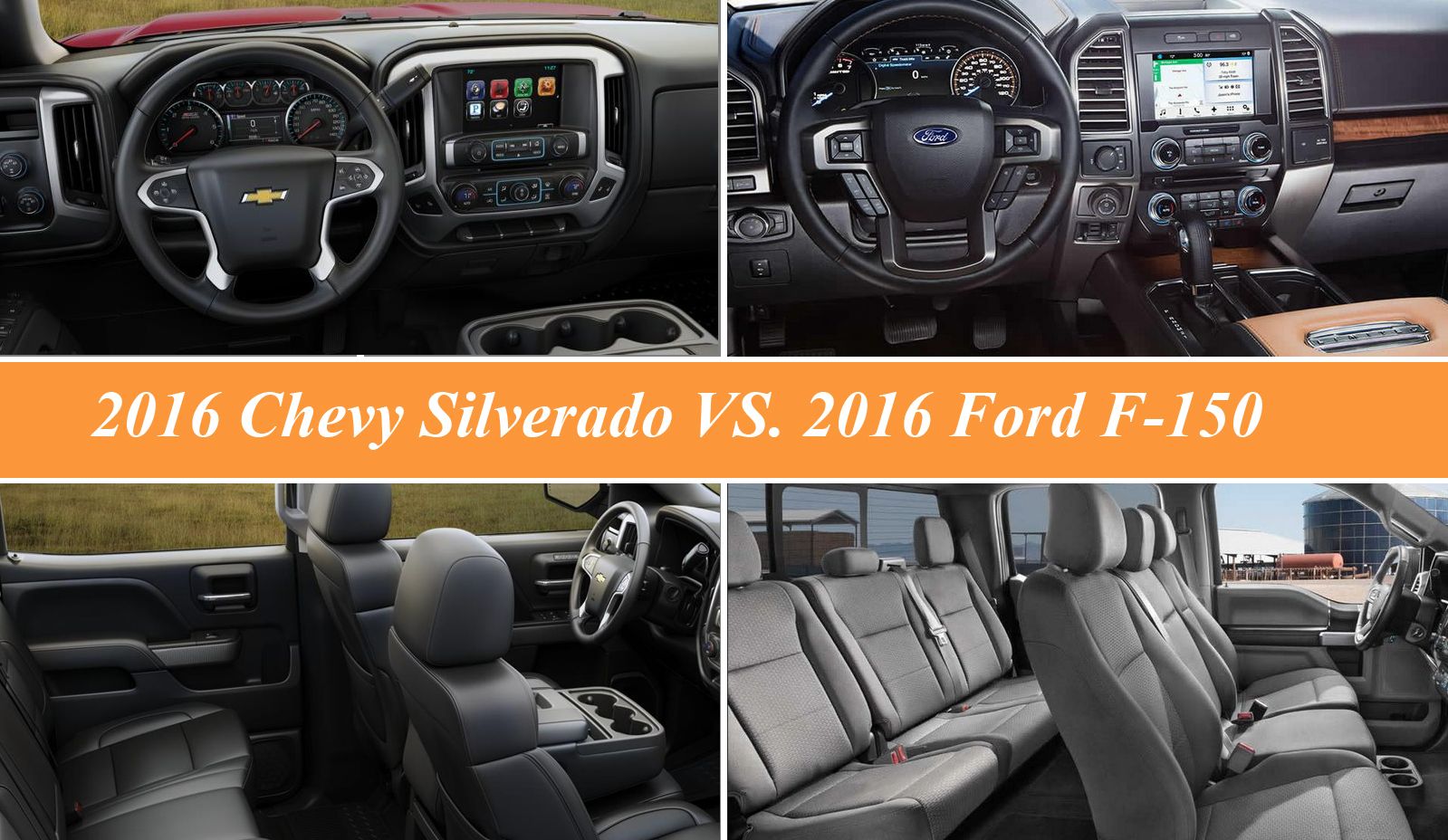Chevrolet and Ford have long been archrivals in the full-size pickup segment, with the Silverado and F-150 battling it out for bragging rights and sales. For the past 39 years, Ford has clinched the sales title, but the Chevy’s pickup has always been close behind. In the bragging rights department, titles of towing and hauling capabilities have moved back and forth with advancements in vehicle design.
The 2016 model year has proved to be a fairly stable year for both the Silverado and F-150, with neither undergoing major updates or changes. That gives us a good chance at comparing the two head to head. For the sake of thoroughness, we’ll include all the possible variations of trucks, including cab and bed configurations, powertrain options, and trim levels.
While a large majority of pickup purchases follow strong brand loyalty, there are plenty of customers new to the pickup segment. These are the folks who don’t have the hardened brand faithfulness and are more likely to objectively shop the entire pickup segment. That’s who we’re targeting here – the undecided buyer wanting to know all the options between the two.
Let us know what you think of the two trucks in the comments below. Which truck would you buy and why?
Continue reading for the full comparison
2016 2016 Chevy Silverado vs. 2016 Ford F-150
- Make: Array
- Model: 2016 2016 Chevy Silverado vs. 2016 Ford F-150
- Engine/Motor: inline-3
- Horsepower: 180
2017 2016 Chevy Silverado vs. 2016 Ford F-150
- Make: Array
- Model: 2017 2016 Chevy Silverado vs. 2016 Ford F-150
- Engine/Motor: inline-3
- Horsepower: 180
- [do not use] Vehicle Model: Array
Exterior
Before we dive into the exteriors of these two trucks, it’s important to understand one thing: looks are subjective. Everybody will have different opinions on the trucks’ aesthetics and what they find appealing. There’s no getting around that.
With that out of the way, the two trucks offers unique styling that reflects their brands’ design language. The Silverado underwent a mild refresh for the 2016 model year, giving the front end some attention after only two years on the market. The grille is more angular with projection beam headlights and LED daytime running lights. The rest of the body remains unchanged from its 2014 introduction.
The F-150 carries on unchanged after its 2015 introduction. Remember, Ford struck out on an innovation crusade with the 2015 F-150, giving it an all-aluminum body, strengthened frame, and a heavily updated interior that’s far more car-like. Both the Silverado and F-150 offer different grille designs that matches up with the various trim levels. Opt for a F-150 XL or Silverado WT and you’ll get a black-plastic grille with black bumpers. Various levels of chrome and brightwork are added to both trucks the higher the trim line. Still, personal preference and budgets determine the better-looking truck.
Cab and bed configurations are a dead tie, of course. Both the Silverado and F-150 come in the three main cab styles – regular, extended, and crew – offering room for three to six passengers, depending on seating configurations. Bed lengths are equally even, with both offering various forms of a short, medium, and log box design. These bed lengths mostly coordinate with the three cab sizes and set number of wheelbase lengths.
Innovation wise, both trucks have their talking points. The Silverado offers cleverly simple corner steps on the rear bumper and hand-grabs at the rear stake mount, making the climb into the cargo bed a simple task. Ford has its optional tailgate step, a design that requires the step be retracted from inside the tailgate and unfolded, along with a grab handle. Each have their advantages, but Chevy does earn points for simplicity.
Likewise, Ford earns points for its optional side-mirror spotlights. These LED lights can be turned on when the truck is stationary, illuminating the area to either side of the truck. This is especially handy at worksites or at the camp grounds.
When it comes to utility, both the Silverado and F-150 offer optional front tow hooks for vehicle recovery and frame-mounted trailer hitch receivers for towing. Both trucks also offer bumper-mounted trailer wiring connectors (both the four- and seven-pin style) for easy hook-ups. Both also offer underbelly skid plates for protection from off-road debris.
Bed utility is also competitive, with both Ford and Chevy offering plenty of dealership add-on parts available for purchase. These include tool boxes, LED lighting packages, and utility ramps. Spray-on bed liners are also available from the factory for both trucks.
Interior
Like the exterior, the interior debate rages within the realm of the subjective – with each person having their favorite. Still, there are plenty of objective points to cover, including seating configurations, infotainment systems, gauge clusters, and trim levels.
Starting with trim levels, the Silverado offers five main options. They are the basic WT, or work truck, the LS and LT options, and the luxury oriented LTZ and High Country trims. Ford offers six trim packages, which include the XL, XLT, Lariat, King Ranch, Platinum, and Limited. Both automakers have aligned their lower trim levels to compete very squarely with the other. The paring is organized as such: WT and XL, LS and XLT, and LT and Lariat. Chevy’s LTZ and High Country trims compete with Ford’s King Ranch, Platinum, and Limited trims. Though the High Country is by no means a penalty box, the F-150’s Platinum and Limited trims offer more high-end features like a dual-pane moonroof and massaging front seats. Yes, the Ford will rub your back as you drive home from work.
While Ford may have the upper hand on Chevy’s interior accommodations, the Silverado’s eight-inch MyLink infotainment system is, in our opinion, easier to use and more graphically interesting. Both systems offer navigation, Bluetooth connectivity, AM/FM/CD/Satellite radio, and voice controls, but Ford’s Sync 3 system won’t offer Apple CarPlay or Android Auto until 2017, with owners of 2016 model vehicles having the chance to upgrade. Chevy’s MyLink comes standard with CarPlay and Android Auto. Ford’s infotainment system does offer one huge advantage over the Chevy – its 360-degree camera system. The driver can see a composite image of the F-150’s surroundings, as well as a front, curb, and rear view.
Charging multiple devices is easiest in the Silverado, thanks to the optional center console’s four USB ports, two 12-volt outlets, and single 110-volt power plug. There’s also USB and 12-volt ports for rear seat passengers as well. Upper trim levels now have a wireless phone charger on the center console lid. Chevy’s center console is also more roomy thanks to the traditional column-mounted gear shifter. Ford’s shifter, at least on upper trim levels, is located within the valuable real estate on the center console. Both brands’ crew cab trucks offer a folding rear bench with a flat load floor, but Ford’s floor is completely flat, making hauling cargo here much easier.
Drivetrain
Chevrolet's 5.3-liter V-8 & Ford's 3.5-liter EcoBoost V-6
What’s a truck without a powerful engine, right? Well, both Chevrolet and Ford have several engine choices that fit a wide range of needs. Ford offers more choices, but Chevy’s engine options, though newly updated, rely on tried and true technology rather than new-age gadgetry.
The Silverado offers three engine choices: the standard 4.3-liter V-6, the mid-range and volume-leading 5.3-liter V-8, and the range-topping 6.2-liter V-8. All three engines are members of GM’s EcoTec3 engine family, meaning they have three main ways of creating power while conserving fuel. These include variable valve timing, a variable displacement system called Active Fuel Management, and direct fuel injection. Despite these technological updates, all three engines share similar architecture to the original small-block V-8 developed in the 1950s, including its cam-in-block, overhead valve design.
The Ford F-150 is embracing the 21st century with small-displacement, forced-induction engines that aim at getting superior fuel economy when unburdened and providing ample power under load. Of the four engine options, two are turbocharged and a part of Ford’s EcoBoost engine family. The 3.5-liter V-6 is the base engine, while the 2.7-liter EcoBoost V-6 is the mid-range upgrade. Those wanting V-8 power can opt for the naturally aspirated 5.0-liter. The range-topping engine is the 3.5-liter EcoBoost V-6. Surprisingly this engine sets the F-150’s highest towing and payload capabilities, as well as offering the most torque in the F-150 lineup.
When it comes to transmissions, both trucks come standard with six-speed automatic units. Chevy is starting to phase in its eight-speed automatic in higher trim Silverados, however. Four-wheel drive systems are equally capable, with both trucks coming with manually operated shift levers in low-level trims and electronically controlled transfer cases in mid- and upper-level trims. Ford does separate itself with the addition of an electronically lockable rear differential – something not found on the Chevy. The Silverado, however, does come with a mechanically locking rear diff, called the Eaton G80 Automatic Locking Differential. Rather than the driver engaging the unit, it relies on wheel slip to lock itself into action, making both rear tires spin at the same speed. Both differential types have their inherent advantages and disadvantages.
Chevrolet Silverado Engines
|
Displacement |
Cylinder Arrangement |
Horsepower |
Torque |
Fuel System |
Best MPG* |
|
4.3-liter |
V-6 |
285 @ 5300 rpm |
305 @ 3900 rpm |
Direct Injection |
18 City/24 Hwy |
|
5.3-liter |
V-8 |
355 @ 5600 rpm |
383 @ 4100 rpm |
Direct Injection |
16 City/23 Hwy |
|
6.2-liter |
V-8 |
420 @ 5600 rpm |
460 @ 4100 rpm |
Direct Injection |
15 City/ 21 Hwy |
*Based on Chevy’s website, citing the optimal cab, bed, and gearing combination.
Ford F-150 Engines
|
Displacement |
Cylinder Arrangement |
Horsepower |
Torque |
Fuel System |
Best MPG* |
|
3.6-liter |
V-6 |
282 @ 6250 rpm |
253 @ 4250 rpm |
Sequential Multi-Port |
18 City/25 Hwy |
|
2.7-liter |
V-6 |
325 @ 5750 rpm |
375 @ 3000 rpm |
Turbocharged, Direct injection |
19 City/26 Hwy |
|
5.0-liter |
V-8 |
385 @ 5750 rpm |
387 @ 3850 rpm |
Sequential Multi-Port |
15 City/22 Hwy |
|
3.5-liter |
V-6 |
365 @ 5000 rpm |
420 @ 2500 rpm |
Turbocharged, Direct injection |
17 City/24 Hwy |
*Based on Ford’s website, citing the optimal cab, bed, and gearing combination.
Pricing
Prices with modern trucks varies wildly depending on cab, trim, and engine options, making the segment one of the widest appealing in the automotive industry. Prices can easily swing from the upper $20,000 range to the upper $60,000 range simply by checking different option boxes.
The Chevrolet’s price point starts at $28,390 for a regular cab, standard box Silverado equipped with the 4.3-liter V-6 in 2WD with zero options. Generally speaking, adding 4WD costs between $3,000 to $4,000, depending on trim grade. Opting for a mid-grade Silverado LT with the popular Crew Cab and standard box with the 5.3-liter V-8 and 2WD results in a $40,980 price tag. The range-topping High Country trim in the Crew Cab, standard box configuration with all the bells and whistles checked can run upwards of $56,000.
The Ford F-150’s price range varies even more dramatically. The base XL in regular cab, short bed form starts at $26,540. Check all the boxes on a Limited trim with the SuperCrew cab, short bed, 3.5-liter EcoBoost with 4WD and the price escalates beyond $64,000. That’s an expensive truck. Of course, most folks will split the gap with an XLT or Lariat trim in 2WD with the 2.7-liter EcoBoost. Prices start at $37,935 and $42,425 respectively.
TopSpeed.com.1}
Both the Silverado and F-150 offer plenty of great features, powerful engine options, high-tech in-dash technology, good looks, and plenty of available options to choose from. Chevrolet and Ford have undoubtedly designed their respective trucks to compete squarely with the other with hopes of clinching more sales and generating profits. Speaking of profits, these trucks represent huge money-makers for both GM and Ford, with both largely responsible for carrying the automakers though difficult times, while allowing for other (and less profitable) projects to be undertaken. It can’t be overstated how important these trucks are to their companies.
Now, which one is better? Well, that all depends on a laundry list of variables determined by each customer’s needs and wants. And of course, those brand-loyal folks will argue all day on why their favorite truck is superior. In short, the choice of truck is largely subjective.
Stick around for more comparative articles like this one here at {TopSpeed.com.} We’ll be sure to cover all the respective truck brands and their products.






